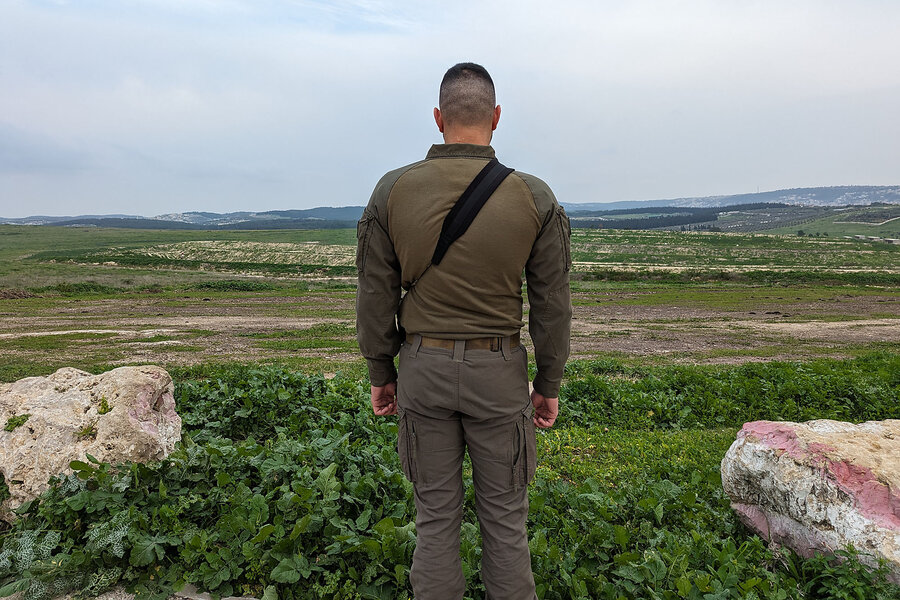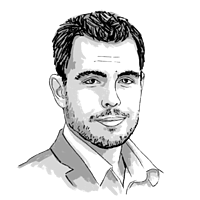Why Oct. 7 has bound Israeli Druze and Jews even more tightly
Loading...
| Daliyat al-Karmel and Beit Jann, Israel
Israeli Druze Arabs, members of a religious minority who have served in Israel’s military for decades, say the Hamas attack has been a turning point in Druze-Jewish relations. Despite prewar tensions over discrimination, the shared threat and an outpouring of support has bound the two communities like never before.
Salih, a 20-year-old Druze soldier seriously wounded in combat on Oct. 7, refuses to discuss certain details about that day. But his distant eyes offer a glimpse into the death he saw.
Why We Wrote This
A story focused onFor the Druze, an Arab religious minority, serving the state in which they live is both a civic duty and a tenet of their faith. Yet after the horrors of Oct. 7 and their losses since, Israeli Druze see the Israel-Hamas war as becoming increasingly personal.
Hamas “did not differentiate between Jewish or Druze, Muslim, Bedouin, or Christian; young or old; men, women, children. They didn’t care,” he recounts, as if still processing the violence. “We must stop terrorism,” he says, clenching his jaw. “Where there is terrorism, there can be no humanity.”
Even amid loss, members of the Druze community say they still hold out hope for peace.
Um Rami, a cafe owner in Daliyat al-Karmel, shakes her head at the news on her phone.
“It was inhumane to see Hamas cart off young children and elderly in cages like animals, and it is inhumane to see children crushed in missile strikes in Gaza,” she says. “Human life must be protected no matter what. That is our spiritual belief and our national duty.”
The events of Oct. 7 are imprinted on Salih’s body and mind.
As he sits outside his former training base in central Israel on a crisp mid-January day, the 20-year-old Israeli Druze soldier recounts carefully the day his unit was deployed to repel a surprise Hamas attack.
That day saw Hamas militants kill 1,200 people, mostly civilians, as they rampaged through southern Israeli towns and kibbutzim, igniting the devastating Israel-Hamas war in Gaza.
Why We Wrote This
A story focused onFor the Druze, an Arab religious minority, serving the state in which they live is both a civic duty and a tenet of their faith. Yet after the horrors of Oct. 7 and their losses since, Israeli Druze see the Israel-Hamas war as becoming increasingly personal.
The day ended with Salih being seriously wounded in combat. He refuses to discuss certain details. But a single glance from his distant eyes offers a glimpse into the death he saw.
Hamas “did not differentiate between Jewish or Druze, Muslim, Bedouin, or Christian; young or old; men, women, children,” Salih recounts, as if still processing the violence. “They didn’t care.
“This was something monstrous, barbaric, against human nature,” he says. “Go to the root definition of ‘terrorism,’ and all of its derivatives, and they all align in this organization.”
For Israeli Druze, the Israel-Hamas war is becoming increasingly personal.
Members of the Arab religious minority, who for decades have served in Israel’s security services, say the graphic Oct. 7 attack and ensuing war have been a turning point in Druze-Jewish relations, with the shared threat and an outpouring of support binding the two communities like never before.
Still on medical leave, Salih, who asked not to use his full name for security reasons, says he’s itching to get back into the fight to protect his 16-year-old sister, mother, and neighbors.
“Each one of us is defending where they live and their family. I am defending myself and my loved ones,” he says. Oct. 7 ingrained in him, and in Druze across Israel, that “terrorism takes away the people you love.”
“We must stop terrorism,” he says, clenching his jaw. “Where there is terrorism, there can be no humanity.”
An emphasis on duty
The Druze, a religious minority found across the Levant, number some 149,000 in Israel, less than 2% of the population. Much of the adult population – men and women – serve in the army, security services, or government agencies. Serving the state in which Druze live is both a civic duty and a tenet of their faith.
Druze civilians are now stepping up to support Israeli Jewish and Bedouin friends and colleagues affected by the attack. Artist Sam Halabi installed a mural in central Tel Aviv commemorating hostages held by Hamas.
“Hamas is ISIS,” he says from his studio in Daliyat al-Karmel, his anger simmering. “They are terrorists who butchered innocent people. Hamas is a cancer. We cannot live in peace and security until this cancer is removed.”
Israeli Druze believe the Islamist Hamas sees them as both “infidels” for their religious beliefs – the monotheists believe in prophets that came after the Prophet Muhammad and in reincarnation – and “traitors” for serving in the Israeli army.
“We know Hamas hates us specifically,” says shopkeeper Abu Hamad. “As Arabs who support Israel, we are doubly targeted.”
Since 1952, Druze men, like Jews, have been drafted into military service. Yet the equality they felt there didn’t always translate to life outside the army.
Druze communities in northern Israel have longstanding grievances against the state, chief of which is that much of their land is registered as “agricultural,” preventing them from acquiring building permits for homes for their children and grandchildren and from expanding their villages.
Others point to discrepancies in budgets their communities receive in comparison with predominately Jewish towns of similar size. Tensions with the government increased with the rise of the Jewish far-right. They came to a head in 2018 when a previous Benjamin Netanyahu-led government pushed through the nation-state law, which stated, “The right to national self-determination in the State of Israel is exclusive to the Jewish people.”
Druze lawmakers failed to challenge the legislation in court as discriminatory, and many today still describe it as a “stab in the back” to non-Jewish Israelis.
Yet today, these tensions – which sparked riots as recently as July – seem a distant memory, minor compared with the existential conflict that Druze and Jews say they face together.
“Any difference or gap between Druze and Jews ... completely disappeared after Oct. 7,” says Zahee Mansour, who along with his wife, Raja, runs the Druze Cultural Heritage Center in the Mt. Carmel village of Isfiya, next to Daliyat al-Karmel. “We have a closer understanding of one another, a better appreciation of one another.”
Aid to Druze communities
Helping smooth relations was an Israeli government announcement Jan. 7 of 12.5 million shekels ($3.41 million) to “strengthen the resilience” of Druze and Circassian communities in northern Israel, and of a five-year plan to develop their communities devised in meetings with Druze leaders and politicians.
In leafy Daliyat al-Karmel, the largest Druze town in Israel, Israeli and multicolor striped Druze flags hang side by side from shops and restaurants, and atop the municipality.
With several thousand Druze men serving in the war in Gaza, the impact of the conflict is being felt in these tightly knit communities across Israel.
Salih, the wounded soldier, says he feels an “absence” in his home village outside Haifa. His cousin Salman is fighting in Gaza, so, too, are neighbors and friends.
“I worry about them because Gaza is dangerous,” he says.
In Beit Jann, near the Israel-Lebanon border, Adi Malik Harb’s photo hangs from buildings and in shop windows across the mountaintop village of 13,000 people.
If you stop anyone in the street, they will eagerly tell you a story about the 20-year-old, who was killed in action Nov. 17 in Gaza.
Yet even amid such loss, members of the Druze community say they still hold out for peace.
“We can be a bridge between the Israelis and the Palestinians. We know both communities and understand the cultures and languages,” says Beit Jann Mayor Radi Najm, glancing at hand-sketched portraits of Mr. Harb on his office shelf. “The Druze community can be a bridge for peace.”
Um Rami, a Daliyat al-Karmel cafe owner, shakes her head as she scans the news on her phone.
“We need more humanity and empathy on all sides,” she says. “It was inhumane to see Hamas cart off young children and elderly in cages like animals, and it is inhumane to see children crushed in missile strikes in Gaza. We don’t want any more civilian deaths, no matter if they are Israeli or Palestinian, Jewish, Muslim, or Druze.
“Human life must be protected no matter what,” she says. “That is our spiritual belief and our national duty.”










